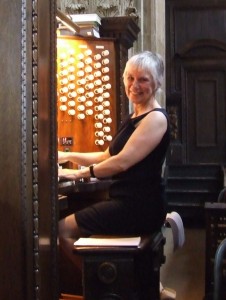Oriental Inspiration
Readers of Organists’ Review will be aware of a short interview column in which a young professional organist has been asked about a ‘Eureka Moment’ or ‘What’s on your iPod’? The answers are always surprising and interesting, indicating a wide range of interests both in and out of the organ world. This article shows how similar the processes of creation of an artistic work can be from one discipline to another, and how inspiration for one’s work can be found in unexpected places.
Most of the time, the TV in our house is switched off but a series about the cultural life of Japan unexpectedly provided joyous moments of illumination. Programmes included descriptions of the Hamada family of Mashiko, Japanese potters, whose dynasty dates back several generations. The work of the artist Hokusai, born in 1760, described his life, painting style, output, and influence, especially on the 20th and 21st centuries. Another striking piece of work was demonstrated by a young calligrapher. Each day, she copies, for two hours, masterworks of calligraphy to keep her mastery of the techniques of using the brush and paint in tip top shape. Before she creates any original work, she ponders what is to be shown, and then conveys it. There is no room for a second attempt, it has to be right first time, whether the canvas is large or small. She described how one’s mood during the process has to be right. For example, an angry mood, may be unknowingly conveyed via the brush stroke, yet discernible by a keen observer.
The artist Hokusai died in his 95th year. His last painting depicts his beloved Mount Fuji, near the top of which a dragon appears to float up to the skies. This is thought to be his ‘farewell to the world’. He was renowned for bringing the character of any animal or person he painted to life, to communicate the personality so well that an observer immediately engages with it. It was as if he had entered the soul of a person, duck, or dragon and was able to express something deep and strong with the simplest brush stroke. The degree to which such things are absorbed are eventually expressed through the way that the hand delicately wields the pen or brush. David Hockney, the Yorkshire artist, is a fan of Hokusai.
What appealed to me was the connection between how the artists studied and prepared their work with tremendous calmness, discipline and precision, combined with a great love for their subject matter. Organ students learn how to prepare scores, and the content of a piece may be discussed in order to work out an efficient learning strategy. It is the same sort of immersion into musical subject matter as artists do with visual subject matter. So often, organists are concerned about getting the notes of the piece right. This is perfectly valid, but the chief impulse, once the notes are learned, is how to play the music in such a way that its character and narrative are communicated, leaving no room for a ‘that will do’ attitude. Attention to detail, practised in the right frame of mind, with the right movements, like the calligraphers and artists, will always yield a good, convincing result, providing that mind and body are relaxed enough to allow the music to flow out. Patience, being a virtue, is essential, so that impatience in learning, which taints the quality of work, is diminished to zero. The idea of learning a masterwork in a week flies away in the face of absorbing what the music is saying through a myriad of beautiful ideas and detail. Perhaps, in order to enhance musical skills and sensibilities, one should learn how to draw, or perhaps rediscover the art of good handwriting to develop a new awareness of hand-eye coordination. In interview, the potter replied that he enjoyed every part of the creative process, from initial design and moulding, shaping, painting, and final firing in the kiln, and that if he rated his work 10/10, there would be nothing left to achieve. Everything was accomplished in quiet surroundings with utmost concentration and no distractions. They have mastered the true art of creating and learning. It is as if I now know what one has to do to play music properly, learned via observing a complementary artistic pursuit, rather than listening to what my teachers had to say!
On a personal note, despite being surrounded by excellent art galleries, I sometimes feel unmoved by such institutions. Perhaps looking at one masterpiece after another is too overwhelming. Listening to vivid descriptions of the creative process of visual art, however, unexpectedly reinforced my thoughts about preparing musical performance. The next day’s practice was suffused with greater uplift, and reaffirmed just how exciting, yet hard work, and time consuming any creative process truly is. When enough work has been done for the session or day, leaving it to settle in body and brain, refreshing oneself by going for a walk is a good idea. It is also wise to remember that low spirits do not necessarily foster good learning, and neither does living on a high all the time.
Many cultures encourage competition through educational extra-curricular activity, prizing early high achievement. Young people have the energy to put the work in. Some thrive on this, some don’t, ending up feeling less than good about themselves. By learning at any point in one’s life what optimum conditions are needed to fulfil personal dreams, the future can look bright for anyone who can grasp them. There are many older people chasing dreams of artistic fulfilment. Being able to respond to eureka moments beyond official retirement is a wonderful privilege.
Postscript
Since completing this article, it seems that committee members had seen the same programmes and been inspired by the same ideas. How lovely that we can respond to these themes and share them.
Marilyn Harper


